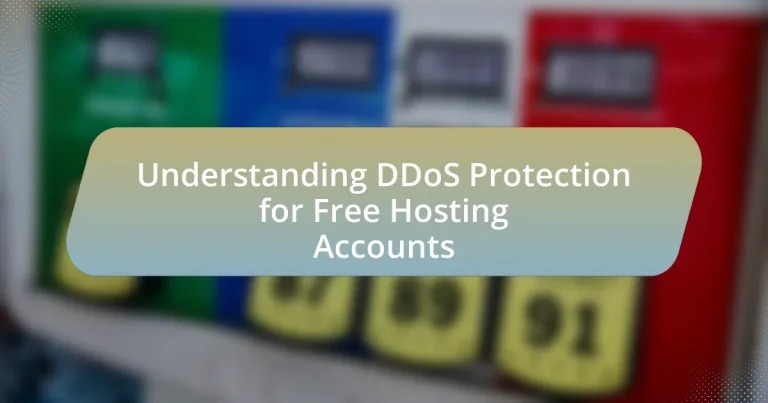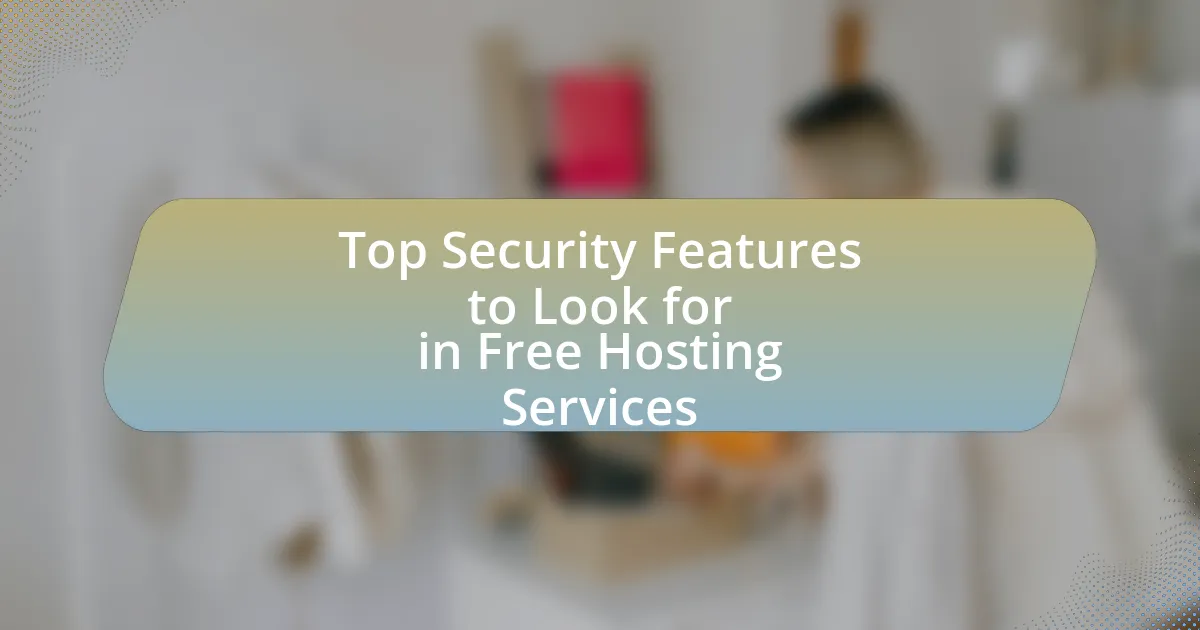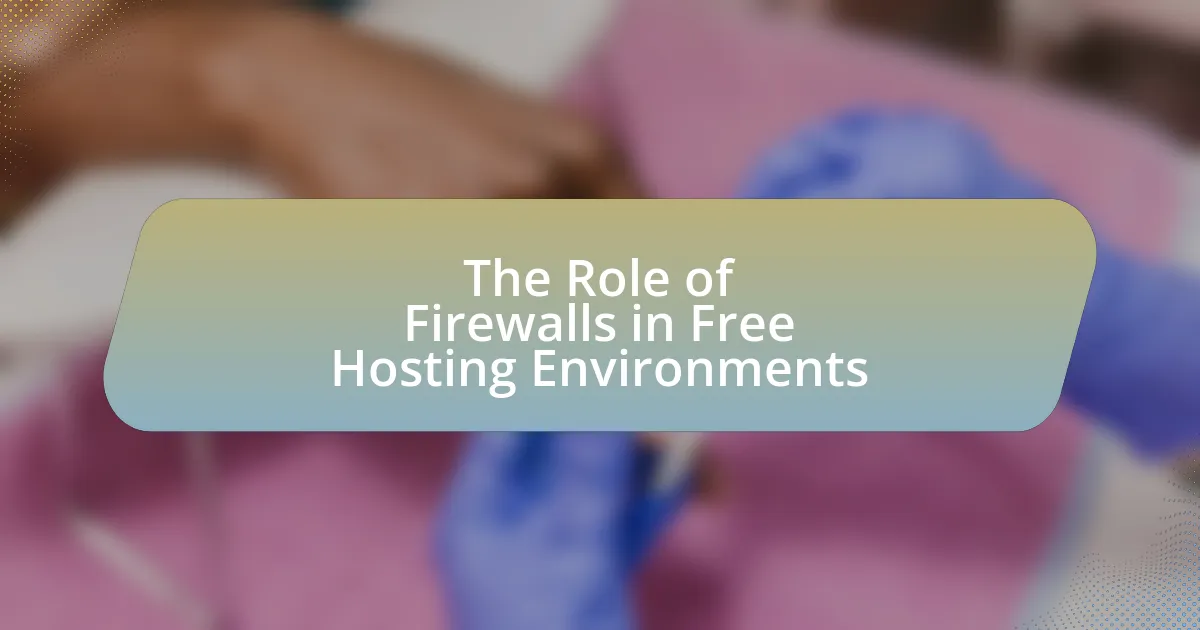DDoS protection for free hosting accounts encompasses security measures designed to defend against Distributed Denial of Service attacks, which can incapacitate servers by overwhelming them with traffic. The article outlines how DDoS protection operates within free hosting environments, detailing key components such as traffic filtering, rate limiting, and threat intelligence. It emphasizes the importance of DDoS protection for free hosting accounts, which are particularly vulnerable due to limited resources, and discusses the various types of DDoS attacks that can affect these services. Additionally, the article explores strategies for implementing effective DDoS protection, the challenges faced by free hosting providers, and future trends in DDoS mitigation technology.
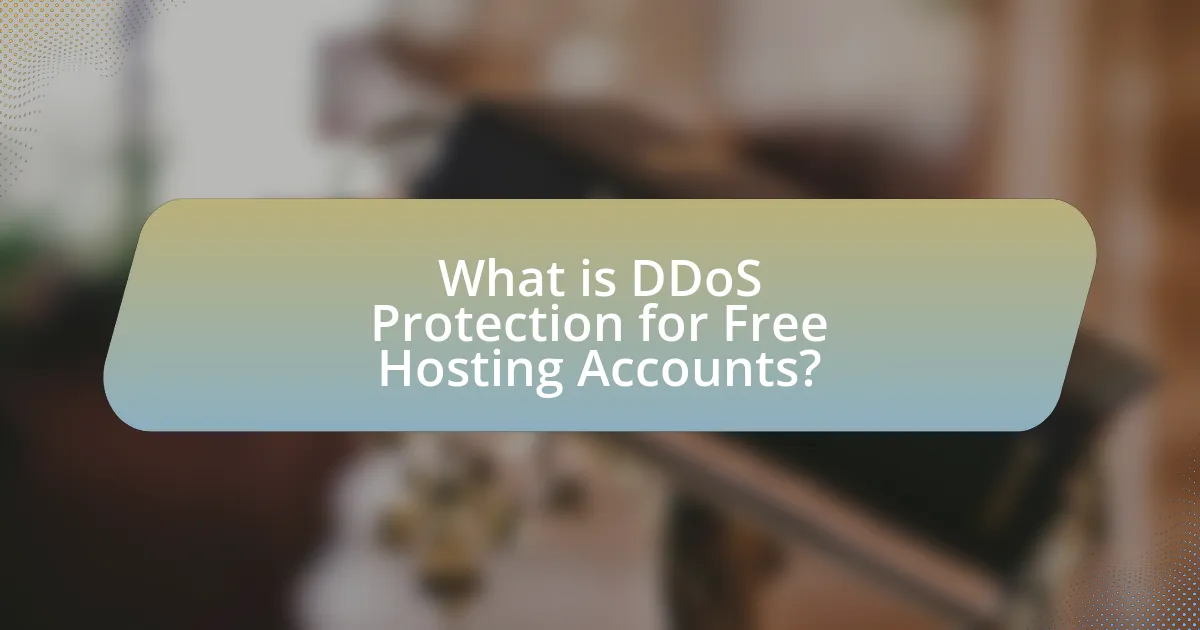
What is DDoS Protection for Free Hosting Accounts?
DDoS protection for free hosting accounts refers to security measures implemented to safeguard these accounts from Distributed Denial of Service (DDoS) attacks, which aim to overwhelm a server with traffic, rendering it inaccessible. This protection typically includes traffic filtering, rate limiting, and the use of specialized hardware or software to detect and mitigate attack patterns. According to a report by the Cybersecurity & Infrastructure Security Agency (CISA), effective DDoS protection can significantly reduce the risk of downtime and service disruption, which is crucial for maintaining the availability of free hosting services that often lack robust security resources.
How does DDoS protection work in the context of free hosting?
DDoS protection in the context of free hosting works by employing various techniques to mitigate the impact of distributed denial-of-service attacks on hosted websites. Free hosting providers often utilize traffic filtering, rate limiting, and IP blacklisting to identify and block malicious traffic while allowing legitimate users access to the service. For instance, many free hosting platforms implement Web Application Firewalls (WAFs) that analyze incoming traffic patterns and can automatically respond to suspicious activity, thereby reducing the risk of service disruption. Additionally, some providers may leverage cloud-based DDoS protection services that can absorb and disperse attack traffic across a larger network, ensuring that the free hosting service remains operational even during an attack.
What are the key components of DDoS protection systems?
The key components of DDoS protection systems include traffic analysis, rate limiting, and threat intelligence. Traffic analysis allows for the monitoring and identification of unusual patterns that may indicate a DDoS attack, enabling timely responses. Rate limiting restricts the number of requests a user can make to a server, effectively mitigating the impact of excessive traffic. Threat intelligence involves gathering and analyzing data on potential threats, which helps in anticipating and preventing attacks. These components work together to enhance the resilience of systems against DDoS attacks, ensuring service availability and performance.
How do these components interact to mitigate attacks?
The components of DDoS protection for free hosting accounts interact by employing a layered defense strategy that includes traffic filtering, rate limiting, and anomaly detection. Traffic filtering identifies and blocks malicious requests before they reach the server, while rate limiting restricts the number of requests from a single source, preventing overwhelming traffic. Anomaly detection monitors traffic patterns to identify unusual spikes that may indicate an attack, allowing for timely responses. Together, these components create a robust defense mechanism that minimizes the impact of DDoS attacks, ensuring service availability and reliability for users.
Why is DDoS protection important for free hosting accounts?
DDoS protection is crucial for free hosting accounts because these accounts are often more vulnerable to attacks due to limited resources and security measures. Free hosting services typically attract a higher volume of users, making them prime targets for Distributed Denial of Service (DDoS) attacks, which can overwhelm servers and disrupt service. According to a report by the cybersecurity firm Akamai, 30% of all DDoS attacks target small and medium-sized businesses, which often include free hosting providers. Without adequate DDoS protection, free hosting accounts risk prolonged downtime, loss of data, and damage to reputation, ultimately affecting user trust and service reliability.
What risks do free hosting accounts face without DDoS protection?
Free hosting accounts without DDoS protection face significant risks, including service downtime, data loss, and reputational damage. Without DDoS protection, these accounts are vulnerable to distributed denial-of-service attacks, which can overwhelm servers with traffic, rendering websites inaccessible. According to a report by the cybersecurity firm Akamai, 30% of organizations experience downtime due to DDoS attacks, leading to potential revenue loss and customer dissatisfaction. Additionally, the lack of protection can expose sensitive data to malicious actors, increasing the risk of data breaches. Thus, free hosting accounts without DDoS protection are at a heightened risk of operational disruption and security threats.
How can DDoS attacks impact the performance of free hosting services?
DDoS attacks can severely degrade the performance of free hosting services by overwhelming their servers with excessive traffic. This influx of requests can lead to slow response times, service outages, and even complete unavailability of hosted websites. For instance, a study by the cybersecurity firm Akamai reported that DDoS attacks can increase latency by up to 50% and cause downtime lasting from minutes to hours, particularly affecting services that lack robust infrastructure. Consequently, free hosting services, which often have limited resources and security measures, are particularly vulnerable to such attacks, resulting in a significant negative impact on their overall performance.
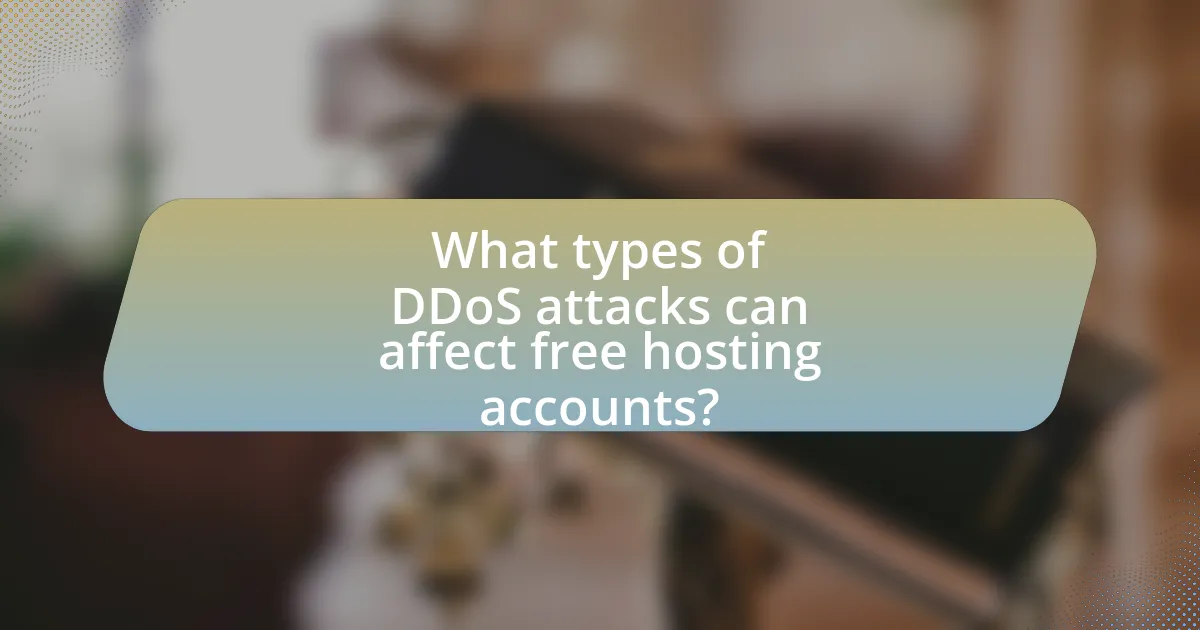
What types of DDoS attacks can affect free hosting accounts?
Free hosting accounts can be affected by several types of DDoS attacks, including volumetric attacks, protocol attacks, and application layer attacks. Volumetric attacks, such as UDP floods and ICMP floods, overwhelm the bandwidth of the hosting service, making it inaccessible. Protocol attacks, like SYN floods, exploit weaknesses in the network protocols to exhaust server resources. Application layer attacks, such as HTTP floods, target specific applications, overwhelming them with requests. These attacks can disrupt services and lead to downtime, particularly for free hosting accounts that often lack robust security measures.
What are the most common types of DDoS attacks?
The most common types of DDoS attacks include volumetric attacks, protocol attacks, and application layer attacks. Volumetric attacks, such as UDP floods and ICMP floods, overwhelm the bandwidth of the target by sending massive amounts of traffic. Protocol attacks, like SYN floods and Ping of Death, exploit weaknesses in network protocols to disrupt service. Application layer attacks, including HTTP floods, target specific applications to exhaust server resources. According to the 2023 Cyber Threat Report by the Cybersecurity and Infrastructure Security Agency, volumetric attacks accounted for over 70% of DDoS incidents, highlighting their prevalence and impact.
How do volumetric attacks differ from protocol attacks?
Volumetric attacks differ from protocol attacks primarily in their method of overwhelming a target. Volumetric attacks aim to consume the bandwidth of the target by flooding it with a high volume of traffic, often measured in bits per second, which can lead to service disruption. In contrast, protocol attacks exploit weaknesses in the protocols used by network devices, targeting specific aspects of the communication process, such as TCP/IP handshake vulnerabilities, to exhaust server resources or disrupt service without necessarily overwhelming bandwidth. For example, a volumetric attack might involve sending massive amounts of UDP packets, while a protocol attack could involve a SYN flood that manipulates the TCP handshake process.
What are application layer attacks and their implications?
Application layer attacks target the top layer of the OSI model, specifically the application layer, which is responsible for end-user services and application protocols. These attacks exploit vulnerabilities in web applications, such as SQL injection or cross-site scripting, to disrupt service or gain unauthorized access to sensitive data. The implications of application layer attacks include significant downtime for affected services, potential data breaches, and financial losses for businesses. For instance, a study by the Ponemon Institute found that the average cost of a data breach is $3.86 million, highlighting the severe financial impact of such attacks.
How can free hosting providers implement DDoS protection?
Free hosting providers can implement DDoS protection by utilizing traffic filtering and rate limiting techniques. Traffic filtering involves identifying and blocking malicious traffic patterns before they reach the server, while rate limiting restricts the number of requests a user can make in a given timeframe, thereby mitigating the impact of potential DDoS attacks. Additionally, free hosting providers can leverage third-party DDoS protection services, which offer advanced detection and mitigation capabilities, ensuring that legitimate traffic remains unaffected during an attack. These methods are effective as they help maintain service availability and protect resources from being overwhelmed by excessive requests.
What strategies can be employed to enhance DDoS protection?
To enhance DDoS protection, organizations can implement strategies such as deploying a Web Application Firewall (WAF), utilizing DDoS mitigation services, and employing rate limiting techniques. A WAF filters and monitors HTTP traffic between a web application and the Internet, effectively blocking malicious requests. DDoS mitigation services, offered by providers like Cloudflare and Akamai, absorb and disperse attack traffic, ensuring that legitimate traffic reaches the server. Rate limiting restricts the number of requests a user can make in a given timeframe, preventing overload from excessive requests. These strategies are supported by industry reports indicating that proactive measures can reduce the impact of DDoS attacks by up to 90%.
How do third-party services contribute to DDoS protection for free hosting?
Third-party services enhance DDoS protection for free hosting by providing specialized mitigation tools and infrastructure that free hosting providers may lack. These services, such as Cloudflare and Akamai, utilize advanced traffic filtering, rate limiting, and anomaly detection to identify and block malicious traffic before it reaches the hosting servers. For instance, Cloudflare reported that it mitigated over 100 billion DDoS attacks in 2020 alone, demonstrating the effectiveness of their technology in safeguarding websites. By integrating these third-party solutions, free hosting accounts can significantly reduce downtime and maintain service availability during DDoS attacks, which is crucial for user experience and business continuity.
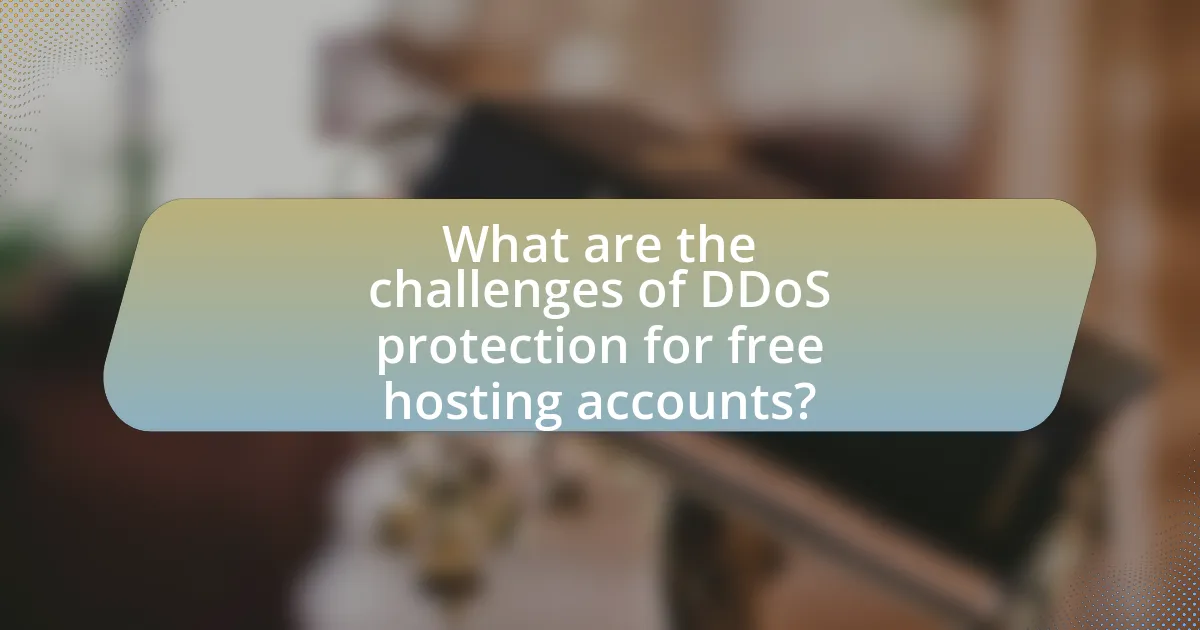
What are the challenges of DDoS protection for free hosting accounts?
DDoS protection for free hosting accounts faces significant challenges due to limited resources and infrastructure. Free hosting services often lack the advanced security measures and bandwidth necessary to effectively mitigate large-scale DDoS attacks, which can overwhelm their servers. Additionally, these services may not have dedicated support teams to respond to attacks promptly, leaving users vulnerable. According to a report by the Cybersecurity and Infrastructure Security Agency, many free hosting providers do not implement robust traffic filtering or rate limiting, making it easier for attackers to disrupt services.
What limitations do free hosting services face in DDoS protection?
Free hosting services face significant limitations in DDoS protection due to their lack of resources and infrastructure. These services often do not have the advanced security measures or dedicated bandwidth necessary to effectively mitigate large-scale DDoS attacks, which can overwhelm their servers. For instance, many free hosting providers rely on shared resources, making it difficult to isolate and manage traffic spikes caused by DDoS attacks. Additionally, they typically lack the financial investment in security technologies, such as firewalls and traffic analysis tools, that are essential for detecting and responding to such threats. Consequently, users of free hosting services are more vulnerable to prolonged downtime and service disruptions during DDoS incidents.
How does resource allocation affect DDoS mitigation efforts?
Resource allocation significantly impacts DDoS mitigation efforts by determining the availability of bandwidth, processing power, and security resources necessary to counteract attacks. When resources are limited, as often seen in free hosting accounts, the ability to absorb and filter malicious traffic diminishes, leading to increased vulnerability. For instance, a study by the University of California, Berkeley, found that inadequate resource allocation can result in a 70% higher likelihood of service disruption during a DDoS attack. Thus, effective resource allocation is crucial for maintaining service availability and resilience against such threats.
What are the trade-offs between cost and protection level?
The trade-offs between cost and protection level in DDoS protection for free hosting accounts involve balancing financial expenditure against the robustness of security measures. Lower-cost options typically offer minimal protection, making systems vulnerable to attacks, while higher-cost solutions provide enhanced security features, such as advanced threat detection and mitigation capabilities. For instance, a study by the Ponemon Institute found that organizations investing in comprehensive DDoS protection experienced 50% fewer successful attacks compared to those relying on basic, low-cost solutions. Thus, while higher costs can lead to better protection, budget constraints often force users to compromise on security, increasing their risk exposure.
How can users of free hosting accounts protect themselves from DDoS attacks?
Users of free hosting accounts can protect themselves from DDoS attacks by implementing several strategies, including using a Content Delivery Network (CDN), enabling rate limiting, and employing web application firewalls (WAF). A CDN distributes traffic across multiple servers, reducing the impact of a DDoS attack by absorbing excess traffic. Rate limiting restricts the number of requests a user can make in a given timeframe, which helps mitigate the effects of an attack. Additionally, a WAF can filter and monitor HTTP traffic to block malicious requests. These methods are effective because they enhance the resilience of free hosting accounts against the overwhelming traffic that characterizes DDoS attacks.
What best practices should users follow to minimize risk?
To minimize risk, users should implement strong security measures such as using complex passwords, enabling two-factor authentication, and regularly updating software. Strong passwords reduce the likelihood of unauthorized access, while two-factor authentication adds an additional layer of security. Regular software updates patch vulnerabilities that could be exploited in DDoS attacks. According to a report by the Cybersecurity & Infrastructure Security Agency, organizations that adopt these practices significantly lower their risk of cyber threats, including DDoS attacks.
How can users identify potential DDoS threats early?
Users can identify potential DDoS threats early by monitoring unusual spikes in traffic and analyzing traffic patterns. These anomalies often indicate that a DDoS attack may be imminent, as legitimate traffic typically follows predictable patterns. For instance, a sudden increase in requests from a single IP address or a significant rise in traffic volume can signal a potential threat. According to a report by the cybersecurity firm Cloudflare, 70% of DDoS attacks are characterized by such traffic anomalies, making early detection crucial for mitigation efforts.
What are the future trends in DDoS protection for free hosting accounts?
Future trends in DDoS protection for free hosting accounts include the integration of AI-driven mitigation strategies and enhanced collaboration among service providers. AI technologies are increasingly being utilized to analyze traffic patterns in real-time, allowing for quicker identification and response to potential DDoS attacks. Additionally, partnerships between free hosting providers and cybersecurity firms are expected to grow, enabling access to advanced protection tools that were previously unavailable to free account users. According to a report by Cybersecurity Ventures, the global cybersecurity market is projected to reach $345.4 billion by 2026, indicating a significant investment in protective measures, including DDoS mitigation, which will likely benefit free hosting accounts as well.
How is technology evolving to combat DDoS attacks?
Technology is evolving to combat DDoS attacks through advanced mitigation techniques, including machine learning algorithms and real-time traffic analysis. These innovations enable systems to identify and filter malicious traffic patterns more effectively, reducing the impact of attacks. For instance, companies like Cloudflare and Akamai utilize AI-driven solutions that adapt to new attack vectors, enhancing their ability to respond to threats dynamically. Additionally, the implementation of distributed denial-of-service (DDoS) protection services has become more prevalent, allowing organizations to absorb and redirect attack traffic, thereby maintaining service availability. According to a report by the Cybersecurity and Infrastructure Security Agency (CISA), the adoption of such technologies has significantly decreased the downtime experienced by businesses during DDoS incidents.
What role will AI and machine learning play in DDoS protection?
AI and machine learning will play a crucial role in enhancing DDoS protection by enabling real-time threat detection and response. These technologies analyze vast amounts of network traffic data to identify patterns indicative of DDoS attacks, allowing for quicker mitigation strategies. For instance, machine learning algorithms can differentiate between legitimate traffic and malicious requests, significantly reducing false positives and improving response times. According to a report by the Cybersecurity and Infrastructure Security Agency (CISA), AI-driven solutions can reduce the time to detect and respond to DDoS attacks by up to 90%, demonstrating their effectiveness in safeguarding free hosting accounts against such threats.
What practical steps can users take to enhance DDoS protection for their free hosting accounts?
Users can enhance DDoS protection for their free hosting accounts by implementing several practical steps. First, they should utilize a Content Delivery Network (CDN) that offers DDoS mitigation services, as CDNs can absorb and distribute traffic, reducing the impact of attacks. Additionally, users should configure their firewall settings to block suspicious traffic and limit access to only necessary ports, which can help prevent unauthorized access.
Moreover, regularly updating software and plugins is crucial, as vulnerabilities can be exploited during an attack. Users should also monitor traffic patterns to identify unusual spikes that may indicate a DDoS attack, allowing for quicker responses. Lastly, employing rate limiting can restrict the number of requests a user can make to the server, further protecting against overwhelming traffic. These steps collectively strengthen the defense against DDoS attacks on free hosting accounts.
